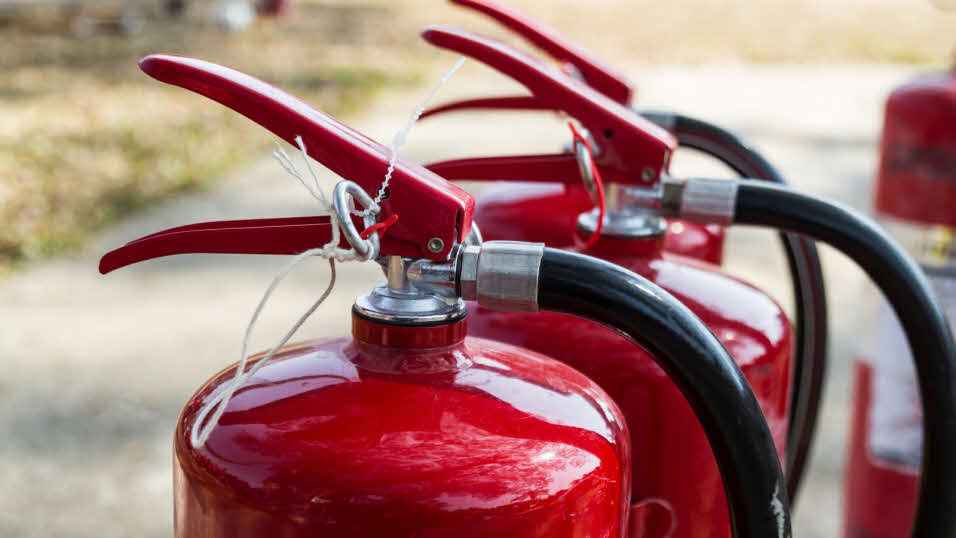Information
Barbecues are permitted on Club sites unless a notice to the contrary is displayed. However, do not leave barbecues unattended and make sure spent charcoal is properly cooled down before discarding.

Fires are extremely rare in caravans and motorhomes, but in the event of a fire emergency, it’s critical to know exactly what to do.
The first rule of fire safety in a caravan or motorhome is simple: in the event of a fire, the first thing to do is to get everyone out as quickly as possible. Only after everyone is safely outside the caravan should you worry about tackling the fire and saving your possessions.
A fire extinguisher should be regarded as standard caravan safety equipment but it’s important that you carry the right type and it is positioned correctly in your caravan or motorhome. You should also know how to use it effectively.
Your fire extinguisher should be manufactured in accordance with BS (EN)3 and tested and approved by the British Standards Institute (BSI) or the Loss Prevention Council Certificate Board (LPCB) or approved by the British Approvals for Fire Equipment (BAFE).
A list of approved extinguisher manufacturers is available from British Approvals Fire Equipment at www.bafe.org.uk.
BS (EN)3 recommends that extinguishers should be coloured entirely signal RED although a different colour-coded area (indicator) on the body may be used so that you can, at a glance, determine the contents, as follows:
Signal red = water
Pale cream = foam
French blue = powder
Carbon dioxide = black
The British Standard Code of Practice for the selection and installation of fire extinguishers is classified according to the alphabet. E.g. A=Water = Organic material, such as wood, B= Flammable Liquids = petrol and diesel etc.
Fire risks are classified according to the alphabet:
| Class A | Involve most organic materials. Such as carbon, wood, textiles and paper |
| Class B | Petrol, diesel, solvents, paints and other flammable liquids |
| Class C | Butane and propane, flammable gases |
| Class D | Flammable metals |
| Class F | Cooking oils and fats |
Although dry powder fire extinguishers are very effective in extinguishing all fires, they are not recommended for use in confined spaces such as caravans. We recommend that AFFF is the most effective for use on a caravan site. However, you should never use AFFF - which is water-based - where electricity is present. AFFF is also not suitable for chip pan or frying pan fires - the water will superheat and cause a flashover. Fire blankets are an effective option for cooking oil/fat fires. Check they conform to BSEN 1869 and look for approval by LPC or BAFE.
It is important that your extinguisher is checked at regular intervals in accordance with the manufacturer's instructions – although replacement is generally an easier and more economic option. The Club’s health and safety manager suggests a typical life expectancy for a caravan extinguisher of 3-5 years. Never use an extinguisher that has been discharged – even partially.
The extinguisher should be located in a dedicated bracket near the door but not too close to cooking appliances, where flames could make it unreachable.
All new touring caravans must by law use flame-retardant foam in the upholstery and match-resistant cushion covers. If you have an older caravan, consider replacing the covers and upholstery with fire-retardant materials.
All National Caravan Council (NCC) approved dealers and manufacturers must fit a smoke detector in all new and second-hand caravans - although this will not apply to privately sold caravans or those sold by dealers outside the NCC. If your caravan does not have a smoke detector, install one made to the appropriate British Standard (BS 5446 Part 1, EN 54-7) Try to fit one that has a 'hush button' which will desensitise the unit for 10-15 minutes. In the confines of a caravan, any cooking is liable to set it off and if you are frustrated into removing the battery, it defeats the object of fitting an alarm.
Fitment of a carbon monoxide alarm is also essential, as exposure to this colourless odourless poisonous gas can be fatal. It is generated by incomplete combustion of carbon fuels (eg a poorly ventilated or defective gas boiler or cooker). Alarms must comply with BSEN 50291-2 of 2019 (performance requirements for CO alarms fitted to recreational vehicles).
There are many potential sources of caravan fires - here are just a few to consider:
To prevent the spread of fire on site caravans should be placed with at least six metres between caravan walls and at least three metres clear between associated equipment (eg. car, awning) and the adjacent caravan. On Caravan and Motorhome Club sites, pitches are always spaced out according to fire regulations for caravan sites but on Certificated Locations and rally fields, it is often up to you to ensure you are properly spaced. With awnings or tents around, particularly in barbecue season, it is wise to keep a full bucket of water handy outside the caravan/awning for emergencies.
All caravan sites have fire risk assessments available on site. All members and visitors to site should adhere to these as instructed by the wardens.
Barbecues are permitted on Club sites unless a notice to the contrary is displayed. However, do not leave barbecues unattended and make sure spent charcoal is properly cooled down before discarding.